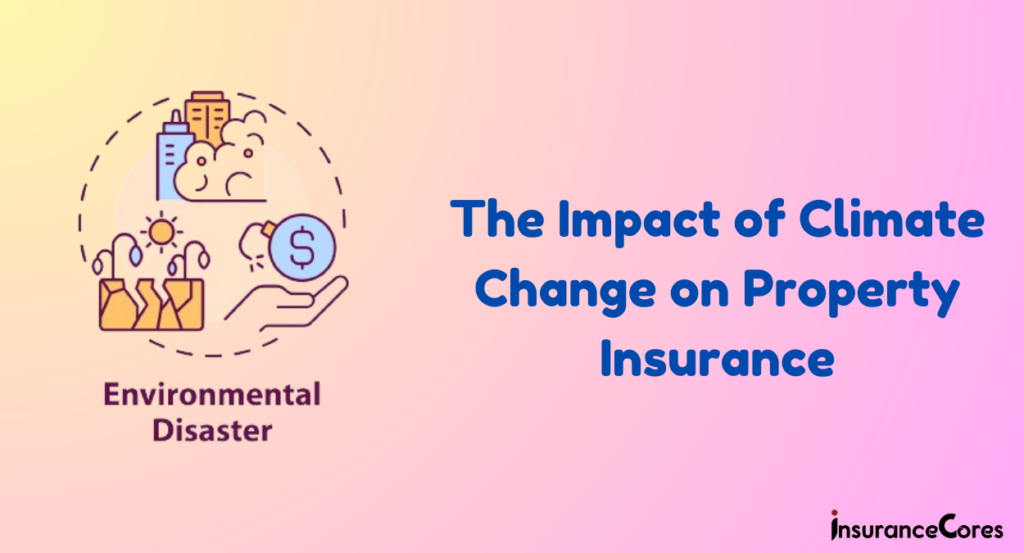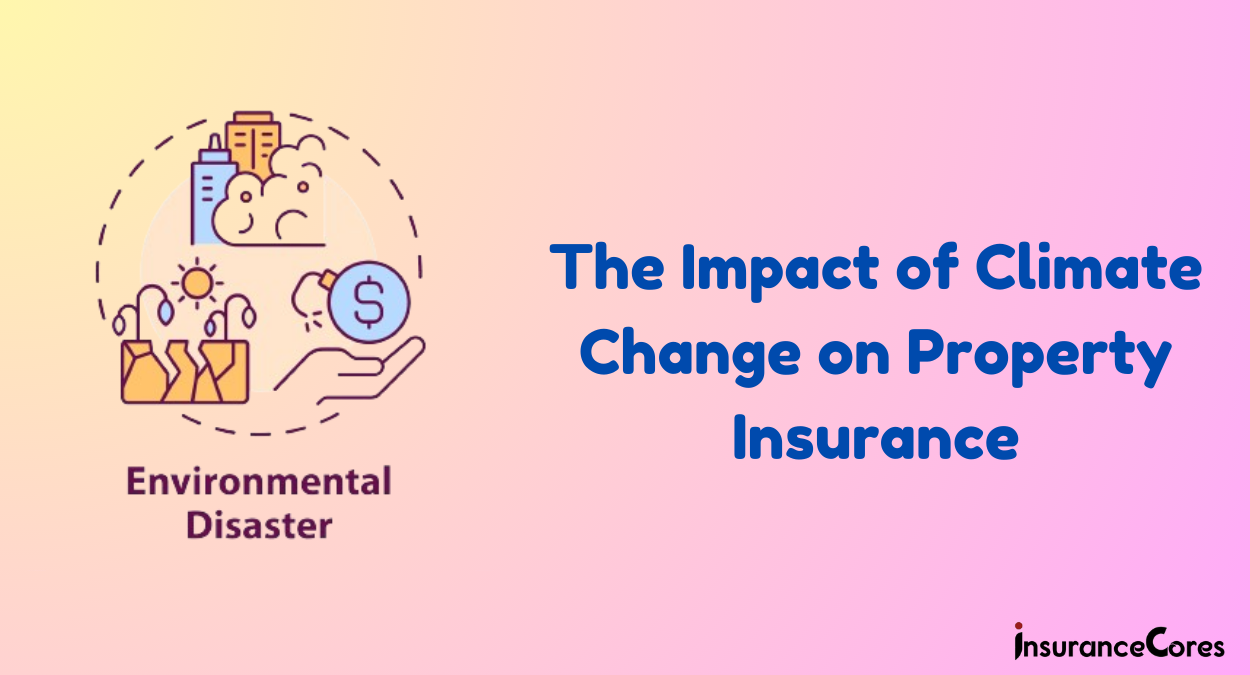Introduction
Climate change is no longer a distant threat; it’s a pressing reality that is reshaping various facets of our lives. One of the most significant areas affected by this global phenomenon is the property insurance sector. As we move through 2024, the impact of climate change on property insurance is becoming increasingly evident. This guide explores how climate change is influencing property insurance, the challenges it presents, and the adaptations necessary for the future.

Understanding Climate Change
What is Climate Change?
Climate change refers to significant changes in global temperatures and weather patterns over time. While climate change is a natural phenomenon, scientific evidence suggests that human activities have significantly accelerated the process over the past century.
Causes of Climate Change
- Greenhouse Gas Emissions: The burning of fossil fuels, deforestation, and industrial processes release large amounts of carbon dioxide (CO2) and other greenhouse gases into the atmosphere.
- Deforestation: Trees absorb CO2, and cutting them down means more CO2 remains in the atmosphere.
- Agricultural Practices: Livestock farming produces methane, a potent greenhouse gas.
- Industrial Activity: Manufacturing processes often release greenhouse gases and other pollutants.
Effects of Climate Change
- Rising Temperatures: Global temperatures are rising, leading to hotter summers and milder winters.
- Sea Level Rise: Melting ice caps and glaciers contribute to rising sea levels, threatening coastal areas.
- Extreme Weather Events: Increased frequency and severity of storms, floods, droughts, and wildfires.
- Ecological Impact: Altered habitats and ecosystems, leading to loss of biodiversity.
Climate Change and Property Insurance
The Relationship Between Climate Change and Property Insurance
Property insurance provides financial protection against damage or loss of property due to various risks, including natural disasters. As climate change intensifies, these natural disasters become more frequent and severe, leading to increased claims and higher costs for insurers.
Key Impacts on Property Insurance
- Increased Claims: More frequent and severe weather events lead to higher claims.
- Rising Premiums: Insurers adjust premiums to cover the increased risk.
- Changes in Coverage: Some areas may become uninsurable, or certain risks may no longer be covered.
- Risk Assessment: Insurers need to continually update their risk models to account for changing climate patterns.
Challenges Faced by the Property Insurance Industry
Increased Frequency of Claims
The frequency of natural disasters such as hurricanes, floods, and wildfires has increased, leading to a surge in insurance claims. This increase puts a financial strain on insurance companies, which must pay out more frequently and in larger amounts.
Higher Costs and Premiums
To compensate for the increased risk, insurance companies often raise premiums. This rise in costs can make insurance unaffordable for some homeowners, particularly in high-risk areas.
Risk of Uninsurability
Certain regions may become too risky to insure. For example, coastal areas prone to hurricanes or low-lying areas susceptible to flooding may face difficulties obtaining insurance coverage. This uninsurability can lead to decreased property values and economic instability in these regions.
Updating Risk Models
Traditional risk models may no longer be accurate due to the changing climate. Insurers must invest in updated technology and data to accurately assess and price risks. This need for continuous updates adds to the operational costs for insurance companies.
Regulatory and Legislative Challenges
Governments and regulatory bodies are also grappling with the implications of climate change on property insurance. New regulations may be implemented to ensure the sustainability of the insurance industry, protect consumers, and encourage mitigation efforts. Navigating these changes can be complex and costly for insurers.
Adapting to Climate Change: Strategies for Insurers
Enhancing Risk Assessment Models
Insurance companies are investing in advanced technologies, such as artificial intelligence and machine learning, to improve risk assessment models. These technologies help in predicting and analyzing climate-related risks more accurately.
Promoting Mitigation Measures
Insurers are encouraging policyholders to adopt measures that reduce the risk of damage from climate-related events. This includes installing storm shutters, reinforcing roofs, and elevating properties in flood-prone areas. In some cases, insurers may offer premium discounts for these mitigation efforts.
Diversifying Risk
To spread the risk, insurers are diversifying their portfolios. This strategy involves insuring a wider range of properties across different regions to minimize the impact of localized natural disasters.
Collaborating with Governments and Communities
Insurance companies are working with governments and communities to improve resilience to climate change. This collaboration may involve supporting infrastructure projects, such as building seawalls or improving drainage systems, to reduce the risk of property damage.
Educating Policyholders
Insurers are increasing their efforts to educate policyholders about the risks associated with climate change and the importance of adequate insurance coverage. This education helps homeowners make informed decisions and take proactive measures to protect their properties.
Case Studies: Climate Change Impact on Property Insurance
Case Study 1: Coastal Areas and Hurricane Risk
Coastal areas are particularly vulnerable to hurricanes, which are becoming more intense due to climate change. For example, in 2022, Hurricane Ian caused significant damage in Florida, resulting in billions of dollars in insurance claims. Insurers in coastal regions have responded by increasing premiums and, in some cases, refusing to renew policies for high-risk properties.
Case Study 2: Wildfires in California
California has experienced a dramatic increase in wildfires over the past decade, driven by higher temperatures and prolonged droughts. The 2018 Camp Fire, the deadliest and most destructive wildfire in California’s history, led to extensive property damage and a surge in insurance claims. As a result, many insurers have raised premiums or declined to offer coverage in high-risk wildfire areas.
Case Study 3: Flooding in the Midwest
The Midwest has seen more frequent and severe flooding events, such as the 2019 floods that affected Nebraska, Iowa, and Missouri. These floods caused extensive property damage and highlighted the need for accurate flood risk assessment. Insurers have responded by updating their flood risk models and, in some cases, requiring additional flood insurance coverage for properties in high-risk areas.
The Future of Property Insurance in a Changing Climate
Technological Innovations
The future of property insurance will likely be shaped by technological innovations. Advanced data analytics, satellite imagery, and the Internet of Things (IoT) will play crucial roles in improving risk assessment and claims processing. These technologies will enable insurers to offer more personalized and accurate coverage options.
Climate-Resilient Building Practices
As awareness of climate change grows, there will be an increased emphasis on climate-resilient building practices. This includes constructing homes and buildings that can withstand extreme weather conditions, such as using fire-resistant materials in wildfire-prone areas or elevating structures in flood zones. Insurers may offer incentives for adopting these practices.
Government and Policy Interventions
Governments will play a critical role in shaping the future of property insurance. Policies that promote climate resilience, such as stricter building codes and investment in infrastructure, will be essential. Additionally, government-backed insurance programs may be necessary to provide coverage in high-risk areas where private insurers are unwilling to offer policies.
Increased Collaboration
The complexity of climate change requires increased collaboration between insurers, governments, scientists, and communities. By working together, these stakeholders can develop comprehensive strategies to manage risks and improve resilience. This collaboration will be crucial in ensuring the sustainability of the property insurance industry.
Must Read:
- What is Universal Life Insurance? Best Way’s to Understanding the Essentials in 2024
- Quick Way’s For Ultimate Guide to Public Liability Insurance: Best Way’s to Protecting Your Business and Assets in 2024
FAQs
What can homeowners do to reduce their insurance costs in a changing climate?
Installing storm shutters and reinforcing roofs to protect against wind damage.
Elevating properties in flood-prone areas.
Using fire-resistant materials in construction.
Maintaining good property upkeep to minimize risks.
Taking advantage of any discounts offered by insurers for mitigation measures.
Are there areas that might become uninsurable due to climate change?
How are insurers updating their risk models to account for climate change?
What role do governments play in addressing the impact of climate change on property insurance?
Conclusion
The impact of climate change on property insurance is profound and far-reaching. As we navigate through 2024, it’s clear that the challenges posed by a changing climate require innovative solutions, collaboration, and proactive measures. Insurers must adapt by enhancing their risk models, promoting mitigation efforts, and working closely with governments and communities.
Homeowners, too, play a critical role in this landscape. By understanding the risks and taking steps to protect their properties, they can contribute to a more resilient future. The road ahead is undoubtedly complex, but with concerted effort and forward-thinking strategies, the property insurance industry can effectively manage the risks associated with climate change and continue to provide essential protection for homeowners.
